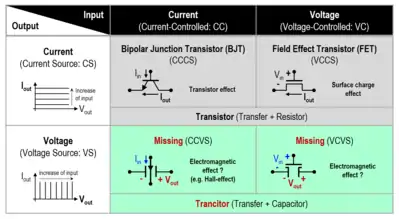Trancitor
The trancitor as the combined word of a "transfer-capacitor" is to be considered as another active-device category besides the transistor as a "transfer-resistor".[2][3] As observed in the table shown, four kinds of active devices are theoretically deduced. Among them, trancitors are missing to be the third and fourth kinds,[1] whereas transistors, such as bipolar junction transistor (BJT) and field-effect transistor (FET), were already invented as the first and second kinds, respectively.[4][5] Unlike the transistor switching the current at its output (i.e., current source), the trancitor transfers its input to the voltage output (i.e., voltage source), so an inverse relationship with each other.[6][7]

History
The term, Trancitor, and its concept were first conceived by Sungsik Lee, a professor at the Department of Electronics Engineering, Pusan National University, South Korea, through his article, entitled A Missing Active Device — Trancitor for a New Paradigm of Electronics, in arXiv uploaded on 30 April 2018,[1] and published on 23 August 2018 in IEEE Access.[2] And the supplementary video was also publicised.[8] This story was first featured by the MIT Technology Review on 23 May 2018, entitled Another "Missing" Component could Revolutionize Electronics.[9] Since then, it has been distributed and discussed by many other internet media and communities.[10][11][12][13][14][15][16][17][18][19][20][21][22][23][24]
See also
References
- Lee, Sungsik (30 April 2018). "A Missing Active Device - Trancitor for a New Paradigm of Electronics". IEEE Access. 6: 46962–46967. arXiv:1805.05842. Bibcode:2018arXiv180505842L. doi:10.1109/ACCESS.2018.2866883.
- Lee, Sungsik. "A Missing Active Device – Trancitor for a New Paradigm of Electronics - IEEE Access". doi:10.1109/ACCESS.2018.2866883. Cite journal requires
|journal=(help) - "The Transistor". www.nobelprize.org.
- "The Transistor - History". www.nobelprize.org.
- "W.F. Brinkman et. al., A history of the invention of the transistor and where it will lead us - IEEE Journal of Solid-State Circuits (Volume: 32, Issue: 12, pp. 1858-1865, Dec 1997)". doi:10.1109/4.643644. Cite journal requires
|journal=(help) - "The Trancitor, Switches Voltage". www.semiwiki.com.
- "Trancitor - Wiki". Golden. Retrieved 2018-07-18.
- LEE Laboratory (24 May 2018). "A Missing Active Device - Trancitor (Another "Missing" Component - Trancitors)" – via YouTube.
- "Another "missing" component could revolutionize electronics". MIT Technology Review.
- "Trancitor, el nuevo componente que podría revolucionar la electrónica". MIT Technology Review, Spain. 28 May 2018.
- "Trancitor Devices could make ICs Smaller, Faster, and Less Power Hungry - PowerPulse.net". powerpulse.net.
- "Another "missing" component could revolutionize electronics - Electronic Components News". 24 May 2018.
- admin. "Another "missing" component could revolutionize electronics - 2NewsNow.com". 2newsnow.com.
- "One other "lacking" part may revolutionize electronics - NEWPAPER24 - Newpaper24 - Global online News around the World". newpaper24.com.
- "PNU 포커스 내용 > 뉴스 > 홍보센터 - 부산대학교". www.pusan.ac.kr.
- "A new theory predicts the existence of an electronic device that works like an inverse transistor. — Electronic & Electrical Engineering". www.ee.ucl.ac.uk.
- "Another "missing" component could revolutionize electronics - Snapzu.com". snapzu.com.
- "New Electronic Component - the "trancitor"". groupdiy.com.
- "r/technology - Another "missing" component could revolutionize electronics". reddit.
- "Trancitor: un nuevo material que revolucionará la electrónica". 14 June 2018.
- "Another "missing" component could revolutionize electronics - Technology News". parameterless.com.
- Group, Techbriefs Media. "A 'Missing' Component Could Revolutionize Electronics - Tech Briefs". www.techbriefs.com.
- "El sucesor del transistor tiene nombre: 'Trancitor' - ElectronicosOnline.com Magazine". ElectronicosOnline.com Magazine (in Spanish).
- López, Juan Carlos (2018-10-04). "Transistores inversos: qué son, para qué sirven y por qué aspiran a reinventar la electrónica" (in Spanish). Retrieved 2018-10-12.